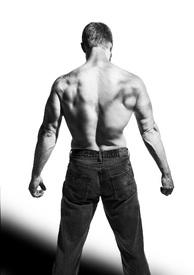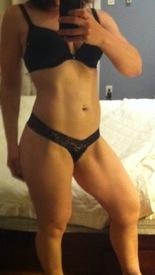Accessories, rep ranges, deficits and whatnot

sjohnny
Posts: 56,142 Member
Right now I'm doing (more or less) 5/3/1 for my weight schedule - I'm probably not the target demographic at whom this program is aimed but it's the schedule that fit best and allowed me to incorporate lifting and running and still have decent leg recovery.
I read Wendler saying that he recommends "bodybuilding" the accessory lifts - sets of 10 or whathaveyou. If one is eating at a deficit does it make any sense to lift in the traditional hypertrophy rep range for the accessory lifts? Would it make more sense to either knock the rep range for them down to 5 or, conversely, shoot for the endurance range?
I read Wendler saying that he recommends "bodybuilding" the accessory lifts - sets of 10 or whathaveyou. If one is eating at a deficit does it make any sense to lift in the traditional hypertrophy rep range for the accessory lifts? Would it make more sense to either knock the rep range for them down to 5 or, conversely, shoot for the endurance range?
0
Replies
-
Great question! I have wondered this myself. I do my accessories in the hypertrophy range but don't know if that usefull in a deficit. Be interested in what some more expert than me have to say.0
-
If it were me, I'd still train in a hypertrophy range for accessory movements.0
-
Hmm good question.
I would keep them at 8-12 reps, and not to failure, purely from a recovery point of view.
Getting stronger in the 8-12 rep range is still getting stronger, however you look at it.
Plus if you are new to lifting, simply doing more reps of the more technical lifts stuff like squats and deads is good practice.0 -
I wouldn't lower the rep ranges for everything, going heavy for everything would screw with your recovery.
For an in-depth discussion of the issue, see these:
http://www.bodyrecomposition.com/training/weight-training-for-fat-loss-part-1.html
http://www.bodyrecomposition.com/training/weight-training-for-fat-loss-part-2.html0 -
Meh.
When you're bulking (or super overweight) you benefit from a surplus of energy and such. Longer, more intense workouts make sense during that time. You want to maximize time under tension and all that good stuff.
When you're cutting, you should not be able to maintain that same workout volume. If you are either you're shortchanging your recovery, you cheated yourself on your bulk, you're half-a**ing it or some combination.
Since you don't want to cut into your staple lifts for this, it makes sense to trim down on the accessory stuff. For me that means dropping the number of sets for each exercise. I don't think dropping the reps down lower is worthwhile because those movements weren't made for max weight style lifting. Power curls, or max weight rows or pulldowns and such are silly. Your form breaks down, you end up trying to heave the weight and work the prime movers a lot more than the smaller muscles you were targetting...you might as well just do the compounds lifts some more at that point.0 -
Personally, I don't bother much with accessory work while cutting, I stick to the compound lifts, then worry about accessory work during bulking and maintenance cycles. Then again, I'm just a recreational lifter working for general health, if I had goals of competition I'm sure I'd think differently. So, I think, as with most fitness and nutrition related things, it comes down to personal goals and preferences.0
-
Thanks, everyone. I'm not going to change anything for the next three weeks but will likely do a revamp at that point. I appreciate all the input.
And thanks, Rock, for the link. I had read that article a while back and forgot all about it.0 -
Great input! I am experiencing some of those recovery issues and have adjusted my routine to 2 days heavy compounds and one day of HIIT and some metabolic work with some walking on the off days. Not sure if the recovery issues are from volume or from age (61). Probably some of both but within 2 weeks of starting the cut they showed up. The articles were very helpful and gave me a greater comfort level that I was on the right track cutting back the volume on the heavy resistance training. Thanks Rock!0
-
I have been having the same internal dialogue myself so I am glad this came up. I have sort of taken a hybrid approach - where the accessories are compounds I drop it down to 6 - 8 and where they are more iso I do 10 - 12. But that is really because I hate hyper range compound lifting rather than any other reason. I also do form work on compounds but that is at a very low weight with higher reps. Also, bear in mind that strength/hyper are a continuum and not a hard cut off between the rep ranges as well.
Glad you brought this up.0 -
Good question and thanks for the articles.
I used a body building 3 day split for most of my weight loss. All in the 8-10 range. I wish I had done more lower rep range work but it sounds like this was still considered the "tension" range.
I didnt have any trouble with recovery doing this. It was usually about 4 days before hitting a muscle group again. For a while a tried to hit each body part twice per week but found I was not able to handle that at all. On my next cut I want to continue the strength work and may need to cut back on the hypertrophy work. We will see.0 -
Great question. I am doing 8-10 for accessory lifts right now in addition to my 5x5 program.0
-
I'm going to read through this more later0
-
Meh.
When you're bulking (or super overweight) you benefit from a surplus of energy and such. Longer, more intense workouts make sense during that time. You want to maximize time under tension and all that good stuff.
When you're cutting, you should not be able to maintain that same workout volume. If you are either you're shortchanging your recovery, you cheated yourself on your bulk, you're half-a**ing it or some combination.
Since you don't want to cut into your staple lifts for this, it makes sense to trim down on the accessory stuff. For me that means dropping the number of sets for each exercise. I don't think dropping the reps down lower is worthwhile because those movements weren't made for max weight style lifting. Power curls, or max weight rows or pulldowns and such are silly. Your form breaks down, you end up trying to heave the weight and work the prime movers a lot more than the smaller muscles you were targetting...you might as well just do the compounds lifts some more at that point.
I want to understad this post more, but something about it is going over my head!0 -
I want to understad this post more, but something about it is going over my head!
A generic lifting routine can be broken down into two pieces:
Your staple lifts (squat, deadlift, clean, etc) are the big compound movements that you're primarily focused on increasing weight. While these have the biggest bang for your buck, they aren't going to have the targetted impact on musculature of the smaller lifts. While you will see physique improvements from these lifts, the primary goal with them should be to get stronger.
Your accessory lifts (bicep curls, barbell rows, leg extensions, etc) are the supporting movements geared towards developing your bodies musculature to ultimately make you stronger at your staples. You don't need to focus as much on increasing weight, as increasing too much will cause form to suffer. Just getting in and banging out medium to high reps on them is usually sufficient.
When you're bulking you're trying to grow muscle mass. You have a surplus in energ and should be able to hit your workouts harder. It would make sense to push your accessory work to see improved musculature gains.
When you're cutting, your primary goal should be to maintain as much strength as possible. Your energy reserves will be limited since you're at a deficit, so your workouts should suffer when compared against them on a bulk. As such, it would make sense to limit your gym sessions somewhat. In that case you'd pare down some of the extraneous stuff (the accessory work) and focus on your core routine (the staple lifts).
A lot of programs have only a few exercises per day. I think of those as the staple lifts to be supplemented with accessory work as needed.
Edit to clarify regarding medium to high reps on accessory work: If you are going for a max squat or max deadlift your form will suffer, period. The extent to which it suffers is pretty dependent on how solid your form is to begin with, and is why beginners should start small to work on form before going all out. As long as you're on point for the most part and keep it close to ideal form though, you should be ok. With smaller movements the scenario is different. Take the Pendlay row, for example. If you cheat the form on it, you're basically doing a half-a$$ed deadlift, in which case you might as well be doing deadlifts, and the benefit of the row at hitting your rhomboids can be lost in the shuffle.0 -
I have been having the same internal dialogue myself so I am glad this came up. I have sort of taken a hybrid approach - where the accessories are compounds I drop it down to 6 - 8 and where they are more iso I do 10 - 12. But that is really because I hate hyper range compound lifting rather than any other reason. I also do form work on compounds but that is at a very low weight with higher reps. Also, bear in mind that strength/hyper are a continuum and not a hard cut off between the rep ranges as well.
Glad you brought this up.
This is kind of what I've been doing too. The compound lifts that I do in addition to the main lift will be at the lower end of that continuum and the iso stuff will be more toward the upper end.
Thanks again, everyone for the insight and ideas.0 -
I want to understad this post more, but something about it is going over my head!
A generic lifting routine can be broken down into two pieces:
Your staple lifts (squat, deadlift, clean, etc) are the big compound movements that you're primarily focused on increasing weight. While these have the biggest bang for your buck, they aren't going to have the targetted impact on musculature of the smaller lifts. While you will see physique improvements from these lifts, the primary goal with them should be to get stronger.
Your accessory lifts (bicep curls, barbell rows, leg extensions, etc) are the supporting movements geared towards developing your bodies musculature to ultimately make you stronger at your staples. You don't need to focus as much on increasing weight, as increasing too much will cause form to suffer. Just getting in and banging out medium to high reps on them is usually sufficient.
When you're bulking you're trying to grow muscle mass. You have a surplus in energ and should be able to hit your workouts harder. It would make sense to push your accessory work to see improved musculature gains.
When you're cutting, your primary goal should be to maintain as much strength as possible. Your energy reserves will be limited since you're at a deficit, so your workouts should suffer when compared against them on a bulk. As such, it would make sense to limit your gym sessions somewhat. In that case you'd pare down some of the extraneous stuff (the accessory work) and focus on your core routine (the staple lifts).
A lot of programs have only a few exercises per day. I think of those as the staple lifts to be supplemented with accessory work as needed.
Edit to clarify regarding medium to high reps on accessory work: If you are going for a max squat or max deadlift your form will suffer, period. The extent to which it suffers is pretty dependent on how solid your form is to begin with, and is why beginners should start small to work on form before going all out. As long as you're on point for the most part and keep it close to ideal form though, you should be ok. With smaller movements the scenario is different. Take the Pendlay row, for example. If you cheat the form on it, you're basically doing a half-a$$ed deadlift, in which case you might as well be doing deadlifts, and the benefit of the row at hitting your rhomboids can be lost in the shuffle.
Thank you so much for that!!! I actually am going to reevaluate my plan now 0
0 -
I agree. Some what.I wouldn't lower the rep ranges for everything, going heavy for everything would screw with your recovery.
For an in-depth discussion of the issue, see these:
http://www.bodyrecomposition.com/training/weight-training-for-fat-loss-part-1.html
http://www.bodyrecomposition.com/training/weight-training-for-fat-loss-part-2.html0
This discussion has been closed.









